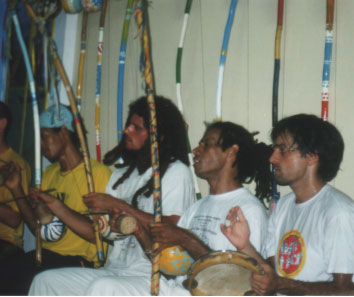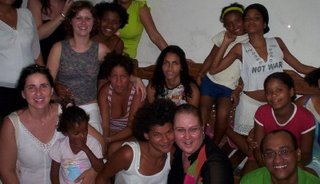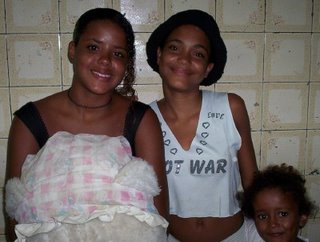 Samba, Sauerkraut and Sensational Soccer!
Samba, Sauerkraut and Sensational Soccer!
In less than 3 weeks, the party begins...It’s a universal truth to state that  the Brazilian national side are the most successful football team in the World.
the Brazilian national side are the most successful football team in the World.Currently preparing themselves in a Swiss lakeside hideaway
for an outstanding attempt at winning a 6th FIFA World Cup.
The squad is brimming with celebrated talent, not least in the shape of the ¨fab four¨ ; Ronaldo, Adriano, Kaka and Ronaldinho.The leading samba boy and captain; Cafu, already holds the record for the most appearances in World Cup Tournaments, and 2006 will be another record busting 4.
Notwithstanding, Ronaldo, is only 2 goals shy of  equaling Germanys, Muller of World Cup goals
equaling Germanys, Muller of World Cup goals (Mullers record is 14).
So all-in-all it could be a very, very, memorable 2006 for all things Brazilian.
The mood in Brazil.Brazilians are very emotive people, very, very proud, yet fun and outgoing too. The mood currently, is
neither euphoric , emotive or nervous, it is more an anticipating , quiet, respectful confidence.Notwithstanding, this will all change upon the blowing of that first whistle in Berlin , on June 13th................. Then my friends – its Showtime!Team BrazilBrazilian Coach: Carlos Alberto Parreira
Advisor/Assistant: Mário Jorge Lobo Zagallo
Squad for World Cup 2006:Keepers:1 - Dida (Milan/ITALY)
12 - Rogério Cenni (São Paulo/BRAZIL)
22 - Júlio César (International/ITALY)
Defence:2 - Cafu (Milan/ITALY)
13 - Cicinho (Barcelona/SPAIN)
6 - Roberto Carlos (Real Madrid/SPAIN)
16 - Gilberto (Hertha Berlin/GERMANY)
3 - Lucio (Bayern Munich/GERMANY)
4 - Juan (Bayern Leverkusen/GERMANY)
15 - Cris (Lyon/FRANCE)
14 - Luisão (Benfica/PORTUGAL)
Midfield:5 - Emerson (Juventus/ITALY)
11 - Zé Roberto (Bayern Munich/GERMANY)
17 - Gilberto Silva (Arsenal/ENGLAND)
20 - Ricardinho (Corinthians/BRAZIL)
19 - Juninho Pernambucano (Lyon/FRANCE)
10 - Ronaldinho Gaúcho (Barcelona/SPAIN)
18 - Edmilson (Barcelona/SPAIN)
Forwards/Attack:8 - Kaká (Milan/ITALY)
9 - Ronaldo (Real Madrid/SPAIN)
7 - Adriano (Internazionale/ITALY)
23 - Robinho(Real Madrid/SPAIN)
21 - Fred (Lyon/FRANCE).
The Group (F)BRAZIL
CROATIA
AUSTRALIA
JAPAN
(Please note that I have placed Group order in anticipated finishing position…)Smiley...THE PLAYBrazil v Croatia (June 13th, Berlin)
Brazil v Australia (June 18th, Munich)
Brazil v Japan (June 22nd, Dortmund)
Overview Objectively, Brazil appear to have a relatively easy Group – and ought to qualify for the 2nd stage with ease.The most difficult game is the opener against Croatia.....
However, suffice to say, its most unlikely that they will face Japan in desperation.
The OppositionCroatiaCroatia deserve the utmost respect, they finished in 3rd place in 88 (France) , and perhaps more importantly for 2006, they qualified by topping their Group, pipping the Swedes on goal difference.
There are no real surprises in their squad – well exposed, but well respected is the order of the day – I think!AustraliaThe Socceroos qualified with ease , winning all of their games, ending four previous play-off failures to boot.
They will give Croatia a run for their money, and it could be a close call for second spot. The Aussies have a good coach in the shape of Guus Hiddink who has recently burdened Mark Viduka with the Captaincy , ahead of former Captain, Craig Moore.
JapanFootball in Japan is growing at a phenomenal rate , and Brazil has played no small part in the boom. Indeed, the enigmatic Brazilian ; Zico is their coach. In addition to this,
Japan and Brazil have for many years had a ¨football¨ relationship, whereby Brazilians have played in the Japanese league and Japanese players are regularly involved in Brazilian league training sessions.
Zico suitably led them to qualify by topping their Group. Moreover, Brazilians have in mind two significant previous encounters. The first of which was the Summer Olympics of 96, when Tha Japs beat them 1 – 0. And subsequently held them to a 2 – 2 draw last year in the Confederations Cup.
The OutcomeVery briefly: I expect the Brazilians to top the Group, with Croatia and Australia running close for 2nd spot – with the Croatians possibly edging it….and the Japanese a gallant, a very gallant , last…
Keep your eyes peeled for future reviews as the final beckons - COME ON BRAZIL.......






















































